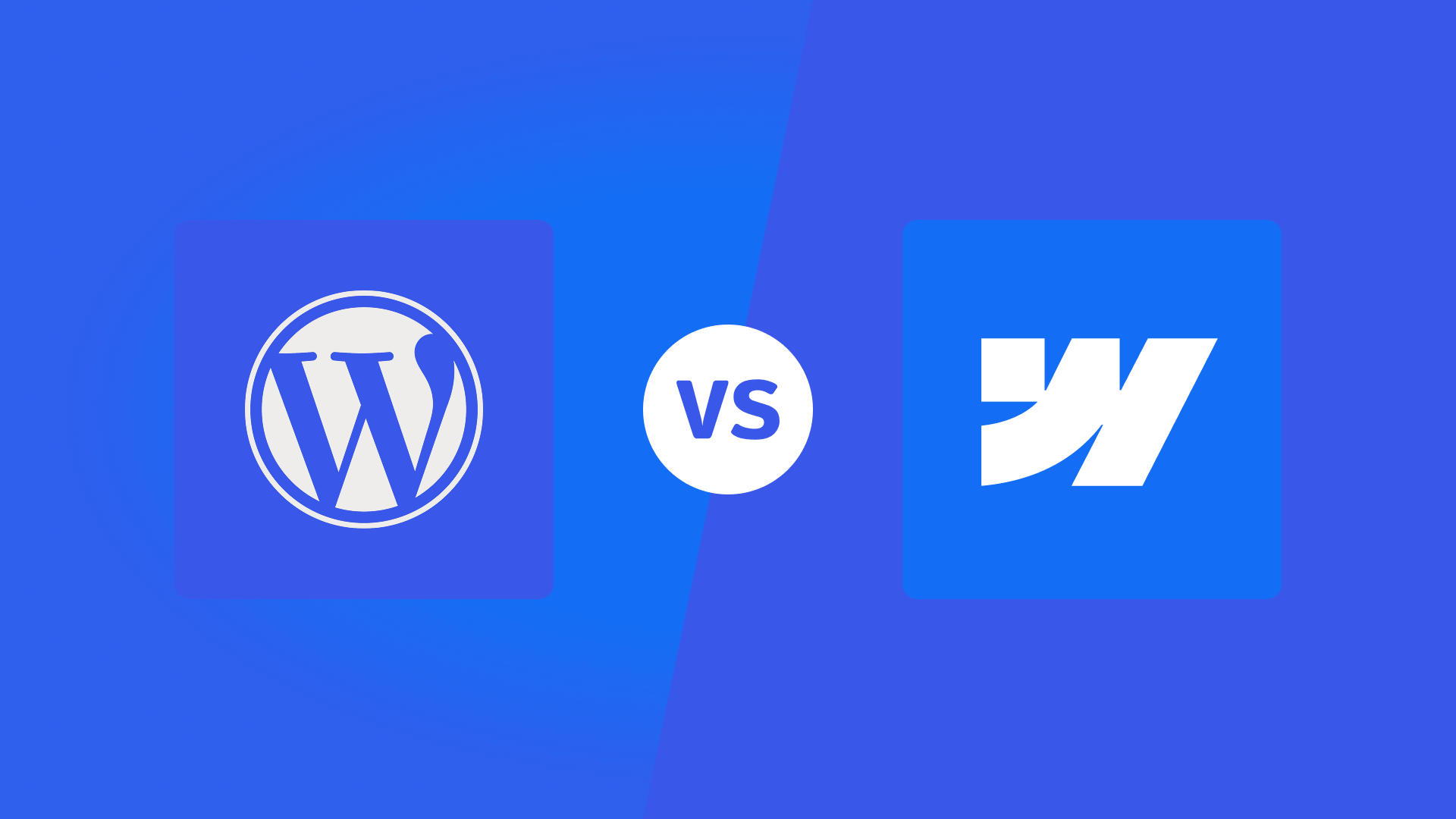This article gives you an objective insight into Webflow compared to WordPress, their history, features and what to expect in the future — written in simple language for those of you who are not necessarily web developers. Choosing the right platform for your new website is a Decisive strategic decision. Before we at Atom Agency start a new web project with a client, the choice is between Webflow and WordPress one of the most common and important issues we face.
History and basic structure
To understand the differences, we first need to look at where the platforms come from.
WordPress: the established CMS giant
WordPress is the world's most widely used content management system (CMS). The platform was founded in 2003 by Mike Little and Matt Mullenweg. Originally, WordPress was designed as a platform for blogging and publishing. Its open source (open-source) format provides users with great flexibility and scalability. Today, WordPress is used by large companies, bloggers and powers over 43% of all websites on the internet.
Webflow: the modern, design-focused tool
Webflow is a more modern platform established in 2012. Unlike WordPress, Webflow is a closed source system. It is a platform that combines design, development and hosting in a single tool, and is sometimes referred to as a “website experience platform”.
Webflow has gained popularity due to its visual, design-first approach, making it possible to build advanced websites without having to write traditional code. Webflow is widely used by designers, agencies and companies that prioritize high aesthetics and performance.
Pros and Cons Webflow vs WordPress
Webflow and WordPress have unique strengths and weaknesses that make them suitable for different types of projects.
Webflow — advantages and disadvantages
Advantages
- Design freedom and control: Offers unlimited customization options and a visual canvas that lets you build sophisticated, responsive layouts without writing code.
- Integrated Hosting and Security: Hosting and security are built into the platform and are managed automatically. This includes automatic caching, SSL certificates and global DDoS protection.
- Automatic maintenance: You never need to update software or manage outdated plugins, as Webflow handles all updates automatically in a secure environment.
- Simple Content Management (Edit Mode): Webflow Edit Mode allows easy content management and real-time collaboration right on the live site.
- Performance and SEO: Generates pure HTML/CSS code, which contributes to faster load times and better SEO performance compared to code that can be “bloated” by many plugins.
Disadvantages
- Cost: Has a license cost, although it is basically low. To use CMS and connect on a custom domain, payment plans are required.
- Learning curve: May have a steeper learning curve for beginners who are not used to design/development principles, making it harder to find good web developers for Webflow.
- Developer/Designer Needs: Creating completely new pages or sections almost always requires the support of a developer or designer. An Editor is more limited in building layouts, but there is an additional user, Marketer, that can build layouts if the developers have prepared for it.
- Locked system: Webflow is a locked system, although it is technically possible to convert a Webflow page to WordPress.
- Limited e-commerce: Works best for small to medium sized ecommerce sites. For large stores with thousands of products or complex shipping needs, it may be less optimal.
WordPress — Pros and Cons
Advantages
- Large ecosystem of plugins and themes: Has a huge selection of themes and over 60,000 Plugins to add basically any feature, from ecommerce (WooCommerce) to SEO (Yoast).
- Open source and low initial cost: The platform is basically free to use.
- Great community and support: A massive and active user base, which means there are endless amounts of documentation, forums and tutorials online.
- Best for content management (blogs): WordPress started as a blogging platform and its CMS, including the Gutenberg editor, is optimized for content creation, categorization, and tagging.
- Unlimited number of users: You can have unlimited number of user accounts at no extra cost, which is ideal for large editorial teams.
Disadvantages
- Security Responsibilities: The website is vulnerable if it is not updated regularly. Security often has to be managed with external plugins and own responsibility.
- Requires external hosting: You have to acquire, pay for, and manage hosting and security yourself, which can be complicated for beginners.
- Performance problems: Too many plugins can lead to conflicts, messy code, and poorer performance, affecting website speed and SEO.
- Technical Complexity: Despite being user-friendly for content, technical installation, maintenance and advanced customization may require code knowledge (HTML, CSS, PHP).
- More difficult to ensure brand uniformity: It can be difficult to control design quality and uniformity across a large organization.
Deep diving: ease of use, design and cost
Ease of use and design possibilities
Both platforms are flexible and can be customized.
- Design: Webflow generally has more opportunities to build better responsive web pages with effects and interactions, often without code. Webflow Designer is a visual canvas where designers can work directly in the interface. WordPress design possibilities depend on the choice of themes and plugins, such as Elementor or Divi, which in themselves have become powerful website builders.
- Content Management: Webflow Edit Mode is easy for a content editor to use and edit text directly on the live page. WordPress requires more technical knowledge, but an Editor with good technical skills can build layouts with the new WordPress Blocks (Gutenberg).
- Collaboration: Webflow facilitates collaboration between designers, developers and marketers thanks to its cloud-based infrastructure and specialized Enterprise tools such as 'Page branching' and clear approval flows. WordPress collaboration relies more on preset roles and permissions.
Cost and maintenance
A common misconception is that WordPress is always the cheapest, but that's not always the case depending on your web project.
- WordPress: The core platform is free. However, there are additional costs for domain, hosting (about 50 — 500 SEK/month) and the necessary premium plugins (can cost anywhere from 200 to 5000 SEK/year per plugin). If your website is growing fast, plugins, hosting and maintenance can be expensive. WordPress additionally requires more maintenance time to handle manual updates of the kernel, themes, and plugins.
- Webflow: Has a license cost, but this includes automatic management of hosting, security and updates. This allows Webflow to be more cost-effective in the long run for growing businesses, as it avoids the unpredictable additional costs and maintenance burden that often come with WordPress. Webflow often reduces the need for both front-end and back-end developers, because the CMS is so integrated.
When you work with Atom Agency we do not make any price difference on development costs or support contracts Whether you choose Webflow or WordPress. We do not want the choice of platform to be driven not by cost, but by what is best for your business.
Future prospects — what can we assume?
Both platforms continue to evolve rapidly, but they do so in different ways.
The Future of Webflow — Towards Integrated AI and End-to-End Solutions
Webflow aims to be a modern, scalable solution, especially for corporate marketing and design-focused projects.
- AI Integration: Webflow leads in AI innovation. The platform has built-in, nativi AI that is woven into the whole system. This includes AI content generation, design systems, and optimization suggestions, something WordPress still relies on third-party plugins for.
- Less reliance on plugins: Webflow integrates more and more features (previously required by plugins in WordPress) directly into the platform, creating a more robust and less cluttered solution.
- Scalability and performance: With built-in hosting management and clean code, Webflow is likely to continue to be the best choice when speed and performance are critical.
The future of WordPress — more visual and improved CMS
WordPress development is driven by its large community and the ongoing Gutenberg project.
- Gutenberg (WordPress Blocks): The ongoing work on the Gutenberg editor aims to make WordPress more visual and intuitive. This gives Editors greater flexibility to build layouts without in-depth code knowledge, reducing the gap to Webflow.
- Transparency and Flexibility: WordPress is likely to maintain its position as the most flexible and customizable solution thanks to its openness and the unprecedented number of plugins. If a project requires a very specific or unusual feature, chances are there's already a plugin for it.
- The budget option: For projects with a limited budget, WordPress will remain the most cost-effective option initially, before costs for premium plugins and maintenance begin to accumulate.
Definitive Recommendation
The choice between Webflow and WordPress boils down to the unique needs of the project and the competencies of the team:
- Select Webflow if: You prioritize visual design freedom, fast development time, high performance, integrated safety and an easy-to-manage system without manual maintenance. Webflow is ideal for design-focused marketing sites and agencies.
- Choose WordPress if: You need the maximum flexibility through third-party plugins, planning a content-heavy project like a blog or large ecommerce, have a very limited initial budget, or have the technical skills/resources to handle hosting and ongoing security updates.
How Atom Agency can help you choose the right one?
To choose from Webflow vs. WordPress is not just a technical decision, but a strategic choice that directly affects your long-term growth and cost-effectiveness. The decision should be based on your unique project requirements and preferences.
We at Atom Agency can help you navigate this complex comparison and make an informed decision by analyzing your specific needs. We offer strategic advice to determine which platform best matches your business goals. This includes examining whether the project requires total freedom of design and high aesthetics (which Webflow excels in), or if you need the maximum Flexibility and the vast ecosystem of plugins that WordPress offers.
Book advice and we'll work it out together!




